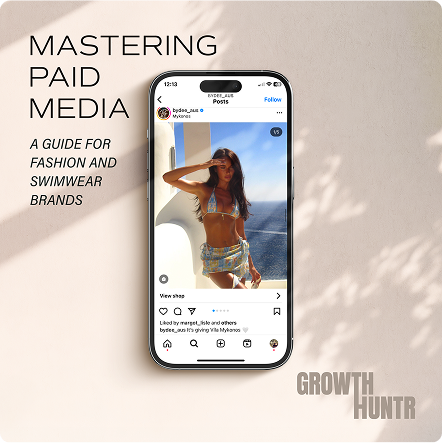In today’s digital age, understanding and effectively utilising paid media is essential for fashion and swimwear brands aiming to scale their businesses. This blog post delves into the intricacies of paid media, offering insights and strategies tailored to help brands navigate this complex landscape.
INTRODUCTION TO PAID MEDIA
Paid media is a powerful tool that allows brands to reach potential customers through targeted advertisements on various digital platforms. It’s essential to understand how paid media works and its impact on the daily lives of consumers scrolling through their social media feeds.
Engaging with ads: An Example
Consider this scenario: you’re scrolling through Instagram, and every fifth post is a sponsored ad. Imagine seeing an ad for jogger pants just when you’ve been searching for them. You click on the ad, explore the collection, but don’t complete the purchase. This interaction is a prime example of how paid media captures user interest and drives them toward a potential purchase.
Understanding the Funnel
In the world of eCommerce, the customer journey is mapped out in a funnel consisting of several stages:
- Page View
- View Content
- Add to Cart
- Initiate Checkout
- Add Payment Info
- Purchase
Each step is tracked as a standard event, providing valuable insights into user behaviour and intent.
DEVELOPING A PAID MEDIA STRATEGY
The goal of paid media is to display the right ad to the right person at the right time. Here’s a
breakdown of how to segment and target your Audience effectively:
Cold Acquisition (1.0 AQ)
- Target users who are unfamiliar with your brand.
- Utilise detailed targeting, lookalike audiences, and broad open targeting to reach new
potential customers.
Warm Acquisition (1.0 AQ Warm)
- Engage users who have interacted with your ads but haven’t visited your website.
- Include those who have watched your videos, liked your posts, or engaged with your social media profiles.
Remarketing (2.0 RE)
- Focus on website visitors who haven’t made a purchase.
- Exclude recent purchasers and lifetime customers to refine your target audience.
Post-Purchase (3.0 PP)
- Target existing customers to encourage repeat purchases.
- Showcase new arrivals, influencer endorsements, and seasonal collections to keep them engaged.
EFFECTIVE REMARKETING STRATEGIES
To maximise the effectiveness of your remarketing efforts, consider these segmentation methods:
Time-Based Segmentation: Target users based on recent website visits, such as the last 30 days.
Frequency-Based Segmentation: Focus on users who have visited your website multiple times.
Interest-Based Segmentation: Tailor your ads to users based on their interests and
preferences.
Event-Based Segmentation: Target users based on specific actions they’ve taken, like
adding items to their cart but not checking out.
Category-Based Segmentation: Reach users who have viewed specific product categories on your website.
Navigating Challenges and Opportunities
While cold acquisition can be challenging, it presents a significant opportunity for brands with strong products and branding. Seasonality plays a crucial role in purchasing behaviour, particularly for swimwear brands. Understanding these patterns and aligning your campaigns accordingly can lead to substantial growth.
Navigating Continuous Testing and Optimisation
Successful paid media strategies require constant testing and optimisation. Experiment with different creative content, strategies, products, and collections. Use data to refine your campaigns and improve performance continuously.
Conclusion
For fashion and swimwear brands, mastering paid media is crucial for capturing the attention of potential customers and driving sales. By understanding user behaviour, effectively segmenting your audience, and continuously optimizing your campaigns, you can leverage paid media to grow your brand and achieve remarkable results. Embrace the power of paid media and unlock your brand’s full potential in the digital marketplace.
This blog post aims to provide fashion and swimwear brands with a comprehensive understanding of paid media, offering practical insights and strategies to help them succeed in the competitive eCommerce landscape.



